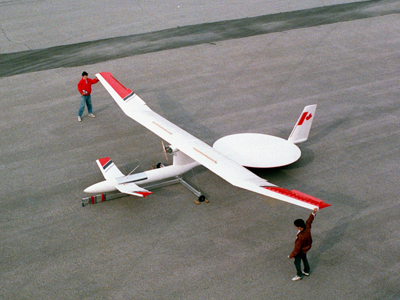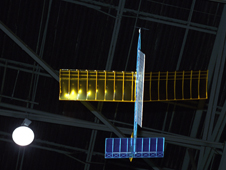
Long Distance Wireless Induction

Canada's SHARP (howstuffworks.com, Wilson)
-
One of the best examples today about how to wirelessly transfer energy over a distance of a few miles is called the Stationary High Altitude Relay Platform (SHARP), an unmanned plane that runs off power beamed from the ground. (Wilson)
-
Created in the 1980's by Canada's Communications Research Center.
-
This microwave powered plane can run for months at a time as long as it stays in range of the microwave transmitter, its range is over 13 miles.
-
SHARP uses a ground based microwave transmitter and the disc-shaped antenna on the back of the plane.
-
The antenna is called a rectenna, which takes the energy transmitted from the ground and converts it into direct current electricity and then powers the parts and systems that need it. (Wilson)

Unmanned remote controlled airplane, powered
by a 1 kilowatt laser (NASA Dryden)
-
Another example of long distance energy transfer was done by NASA Dryden. (Curry)
-
The main problem with this system is that in order to give energy to the plane there must be a clear path for the laser to a panel of infrared-sensitive photovoltaic cells.
-
They used laser rather than the microwave beam, because of the main drawback of microwave beams, which is as you get more distance from the source of the beam dissipates more and more.

Slide 1 (Title page)
- Slide 2 - Slide 3 - Slide 4
- Slide 5 - Slide 6
(Conclusion) - Slide 7
(Bibliography)


